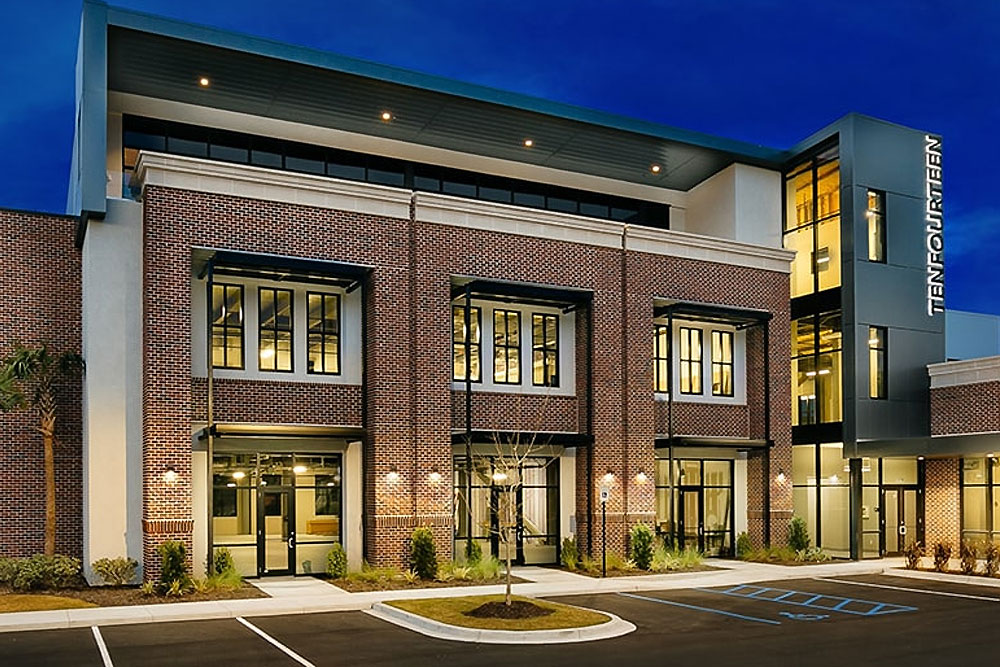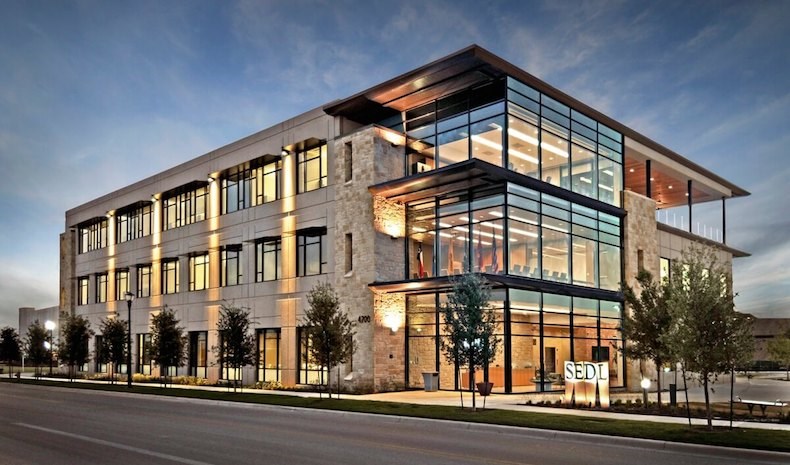Unveiling the Comprehensive Providers Supplied by Commercial Architects for Modern Advancement
Commercial Architects serve a critical function in modern development projects. They mix style aesthetic appeals with capability while adhering to regulatory demands. Their knowledge prolongs past simple building, incorporating sustainable practices and innovative modern technologies. As they browse complicated zoning laws, Architects team up with numerous stakeholders to bring visions to life. This multifaceted strategy questions about the evolving role of Architects in shaping modern areas and the impact of their work with future growths.
Comprehending the Duty of Commercial Architects in Modern Developments
In modern city landscapes, Commercial Architects play an essential duty fit useful and aesthetic spaces that satisfy varied company requirements. Their competence prolongs beyond simple design; they browse complex zoning regulations, constructing codes, and environmental laws. By teaming up with clients, they determine details needs, ensuring that each task lines up with the customer's vision while additionally taking into consideration functional elements such as sustainability and cost-effectiveness. Commercial Architects are proficient at incorporating innovative modern technologies and products right into their layouts, boosting both the functionality and energy effectiveness of structures. They conduct comprehensive site evaluations to examine the possible challenges and chances provided by an area. Furthermore, efficient interaction with service providers and various other stakeholders is essential, making certain that the task progresses efficiently from perception to conclusion. Inevitably, Commercial Architects contribute in developing spaces that not just fulfill functional functions yet likewise add to the general character and vibrancy of city atmospheres.
Concept Style: Transforming Concepts Into Reality
Principle style works as a crucial phase in Commercial style, where cutting-edge design services arise from creative brainstorming. This procedure counts on joint ideation, bringing with each other varied perspectives to refine and improve initial concepts. As concepts form, they transform from abstract concepts right into concrete building truths.
Innovative Style Solutions
Changing ideas into reality is the trademark of innovative layout solutions in Commercial architecture. These services blend imagination with performance, dealing with the special demands of modern-day advancements. By leveraging innovative innovations and sustainable methods, Architects craft areas that are not just visually attractive but also reliable and versatile. Emphasis on user experience drives the style process, guaranteeing that settings foster productivity and partnership. Each task gain from a tailored technique, where ideas are diligently developed to show the client's vision while considering future trends. Innovative design options likewise prioritize adaptability, permitting alterations with time as organization demands advance. Ultimately, these methods improve the general value of Commercial rooms, making them pivotal in today's competitive landscape.

Collaborative Ideation Process
Collaboration serves as the backbone of the ideation process in Commercial design, promoting imagination and innovation amongst diverse stakeholders. Architects, clients, designers, and neighborhood participants involve in dynamic conversations, ensuring that all point of views are considered. This comprehensive method permits for the exploration of various style principles, motivating special solutions that straighten with the task's vision. Via workshops and brainstorming sessions, concepts evolve and improve, transforming initial concepts into concrete designs. Technology additionally plays a crucial duty, with tools such as Structure Information Modeling (BIM) assisting in real-time collaboration and changes. Eventually, this joint ideation process not only enhances the layout result but likewise cultivates a sense of ownership and investment amongst all parties included, bring about successful Commercial growths.
Zoning Evaluation: Browsing Regulations and Conformity
As programmers commence on new projects, understanding zoning regulations is necessary to making sure conformity and preventing pricey delays. Zoning analysis plays an essential duty in this procedure, as it entails examining neighborhood zoning laws that dictate land usage, building height, thickness, and troubles. Commercial Architects have the experience to browse these complicated regulations, assisting customers recognize permissible usages and any kind of needed variances.
Sustainable Style Practices: Structure for the Future
Sustainable layout practices are progressively essential in the domain name of Commercial architecture, specifically as environmental problems proceed to escalate. Architects prioritize environment-friendly products, energy-efficient systems, and layout strategies that lessen waste and environmental impact. Integrating renewable resource sources, such as photovoltaic panels and wind generators, enables structures to generate their very own power and reduce reliance on fossil fuels.Furthermore, sustainable layout emphasizes the importance of interior environmental high quality. This consists of using all-natural light, enhancing air flow, and choosing non-toxic materials to boost occupant health and wellness and productivity. Eco-friendly roofing systems and living wall surfaces are additionally preferred attributes that contribute to biodiversity and metropolitan cooling.Additionally, Commercial Architects commonly integrate water conservation strategies, like rain harvesting and drought-resistant landscaping. Through these ingenious strategies, they create rooms that not just satisfy modern needs but also promote a sustainable future, attending to the expanding need for liable development in the contemporary world.
Job Monitoring: Ensuring Timely and Efficient Implementation
Efficient project management is crucial for guaranteeing that Commercial style tasks are finished on time and within budget plan. This role encompasses a variety of duties, including the sychronisation of numerous stakeholders, timelines, and resources. Commercial Architects utilize their know-how to create in-depth job strategies that detail important landmarks and deliverables, permitting organized progression tracking.Regular interaction amongst staff member and clients is vital, fostering openness and helping with punctual decision-making. Risk monitoring strategies are also employed to identify prospective obstacles early, allowing aggressive solutions to be developed. By using sophisticated project management tools, Architects can check project performance in real-time, making adjustments as essential to maintain performance.
Interior Design: Producing Useful and Visual Areas
Interior decoration plays an essential duty in boosting both performance and aesthetics within Commercial areas. Reliable YOURURL.com room preparation can maximize process and enhance user experience, while visual style principles add to an aesthetically attractive atmosphere - commercial architects. Together, these elements develop spaces that are not just sensible however likewise inspiring
Room Preparation Performance
While making best use of the energy of available space, Commercial Architects prioritize room planning effectiveness to create both useful and cosmetically pleasing settings. This approach includes mindful evaluation of the spatial format to assure ideal use of every square foot. Architects think about factors such as workflow, availability, and all-natural light to improve use. By strategically putting furniture, tools, and workstations, they help with motion and interaction amongst individuals, advertising efficiency. Furthermore, zoning various areas for details features aids in handling noise and privacy, developing an unified environment. Via reliable area preparation, Commercial Architects can change constraints right into chances, making certain that each space fulfills the varied demands of its occupants while sticking to governing needs and industry standards.
Visual Layout Concepts
Aesthetic design principles play an essential duty in shaping settings that are not just useful but additionally visually enticing. These principles guide Commercial Architects in creating rooms that reverberate with customers while improving brand identification. Key components consist of balance, percentage, and harmony, which interact to produce a cohesive appearance. Shade schemes and products are meticulously picked to evoke preferred emotions and sustain the total theme. Furthermore, lighting plays a vital duty, affecting mood and presence while highlighting building features. By integrating these principles, Architects assure that spaces are not only practical but likewise welcoming and inspiring. Ultimately, effective visual style cultivates a positive user experience, encouraging engagement and contentment in Commercial settings.
Partnership With Stakeholders: Cultivating Effective Collaborations
Successful partnerships in Commercial architecture rest on reliable partnership with stakeholders, ensuring that every voice is heard and valued. This joint approach entails interesting different celebrations, consisting of customers, service providers, and community members, throughout the design and growth process. By fostering open interaction, go right here Commercial Architects can address problems, collect understandings, and straighten the project's vision with stakeholder expectations.The integration of varied point of views boosts imagination and development, bring about more useful and cosmetically pleasing layouts. Routine conferences, feedback sessions, and workshops promote this dialogue, enabling Architects to adapt their strategies in response to stakeholder input. On top of that, developing depend on via transparency and accountability reinforces these collaborations, causing a smoother project execution.Ultimately, the success of modern developments depends upon the Architects' ability to navigate and integrate differing interests, creating a collaborative setting that promotes shared goals and mutual success.
Frequently Asked Concerns
Just How Do Commercial Architects Take Care Of Budget Plan Constraints During a Job?

What Kinds of Software Application Do Commercial Architects Commonly Use?
Commercial Architects typically utilize software program such as AutoCAD for composing, Revit for Building Info Modeling, SketchUp for 3D modeling, and task management tools like Microsoft Job to enhance cooperation and improve workflows throughout the layout procedure.
Can Commercial Architects Aid With Getting Funding for Projects?
Commercial Architects can help in obtaining funding for tasks by preparing comprehensive proposals, aiding to articulate style visions, and supplying economic projections that can boost the likelihood of protecting essential funding from capitalists or banks.
How Do Architects Make Certain Safety Throughout the Construction Refine?
Architects ensure safety and security throughout building and construction by executing strenuous design standards, collaborating with designers, carrying out routine website examinations, adhering to regional regulations, and fostering interaction among all stakeholders to minimize dangers and advertise a safe and secure workplace.
What Continuous Assistance Do Architects Supply After Job Completion?
After job completion, Architects offer ongoing support with maintenance examinations, efficiency evaluations, find more information and design alterations. They ensure buildings satisfy evolving needs, address potential issues, and keep compliance with regulations, cultivating a lasting relationship with clients.